





One of the first perennials grown as a garden ornamental were the monkshood. Hundreds of years later they still remain popular. Today there are more than just the standard blue species. Now you can get white, pale blue, various shades of pink and even yellow. However, gardeners beware! This plant has a deadly side....it is among the most toxic plants out there! Read more about this fascinating genus of plants.
Many gardeners, especially those who live in colder regions, are familiar with Aconitum, commonly called monkshood or wolfsbane. Most are tall, long-lived perennials primarily native to moist mountainous regions of the Northern Hemisphere. There are about 250 species, although only a handful are commonly grown as ornamentals. Plants generally produce a stout, unbranched stem arising 1-2 m. Their leaves are mostly smooth, deep green, somewhat glossy, palmate in outline with multiple, deeply divided lobes. The flowers are produced as a terminal raceme of blue or white flowers (more rarely yellow or pinkish). The 5 ‘petals' are actually modified sepals that look petaloid. The uppermost sepal is further modified to form a hood-like structure commonly called the helmet or hood. The true petals are reduced to form 2 tube-like nectaries concealed within the helmet and several scale-like projections around the stamens. The blooming season is mid-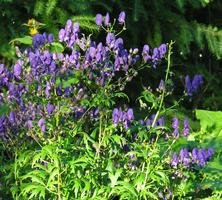 late summer and into fall.
late summer and into fall.
As garden plants, they are used primarily in the back of the border. They may be grown in full sun or part shade. If they are exposed to enough sun, they are often quite wind-resistant and do not require staking. In shadier sites, staking may be required. The soil should be evenly moist but well-drained. The soil pH does not seem to matter as they grow equally well in acidic or alkaline soil. Plants arise from a thick, tapering root. They generally resent transplanting and will sulk their first year but then they rebound, perhaps too vigorously! It is best to transplant them in fall rather than spring.
Monkshood, in particular, Aconitum napellus, have been popular cottage garden plants for hundreds of years and was certainly one of the earliest garden ornamentals to follow the European settlers to North America. Many old heritage gardens will portray monkshood. In my area of Newfoundland, Canada, monkshood have been cultivated for well over 150 years. I've seen them growing in the most extreme locations; within a few meters of the open North Atlantic. In such situations, virtually nothing other than hardy grasses can survive, yet the monkshood persevere. Hardiness is not a problem as many will survive zone 3. 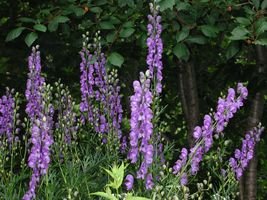
So, here we have a garden ornamental that is long-lived, easy care, showy and tough as nails. Sounds perfect! Well, perhaps too perfect. Unfortunately, monkshood has a more sinister side, in fact, it is downright deadly! All parts of Aconitum, especially the roots, are full of an alkaloid called aconitine. Aconitine first stimulates and later paralyzes the nerves of pain, touch, and temperature if applied to any mucous membrane. Even abraded skin can absorb a dangerous dose of the compound and merely tasting some of the plant can and has proven fatal. Native peoples have taken advantage of this poison for millennium. Juice from the roots was commonly utilized to poison arrow tips used for hunting and warfare. The other common name, wolfsbane, may refer to the mythological connection of this plant to werewolves. Some mythologies claim the plant could be used to repeal werewolves, while others claim it actually leads to lycanthropy! Monkshood are certainly not a boring plant! So the moral of the story; practice extreme caution when handling this plant and if small children are part of the equation, then you should probably avoid growing monkshood. Older children and teens should be educated about the risks of the plant as accidental poisonings by ingestion of monkshood are not unheard of.
Now that I've scared you from growing them, I'll describe the common species and cultivars in the hopes of swaying you back to the positive qualities of monkshood as a garden ornamental...after all, monkshood are not alone in being highly toxic garden plants. Datura, castor bean and foxglove are also highly poisonous yet popular garden plants.
As mentioned, Aconitum napellus, the common monkshood, is by far the most commonly cultivated species which is not surprising as it has the widest distributional range of any species growing across Eurasia. The wild form has typical deep blue flowers. It also comes in a white form called ‘Album'. A hybrid between it and A. variegatum, called X cammarum, contains most of the named forms including ‘Bicolor' (two-tone blue and white), ‘Eleonor' (white with thin blue margin), ‘Carneum' (greyish-pink), ‘Roseum' (light pink), ‘Bressingham Spire' (violet-blue), ‘Newry Blue' (looks almost blue-black from a distance), ‘Stainless Steel' (pale blue hybrid between X cammarum and an alpine species from Asia) and ‘Pink Sensation' (a true pink hybrid between X cammarum and carmichaelii).
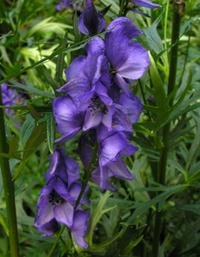
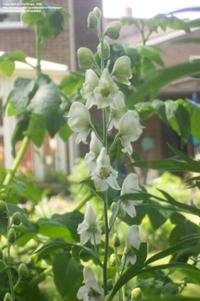
Above are Aconitum napellus and the variety 'Album'
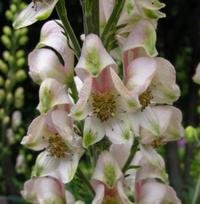
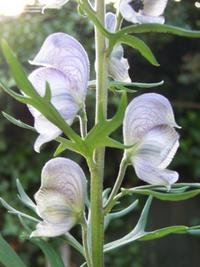
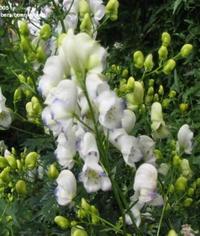
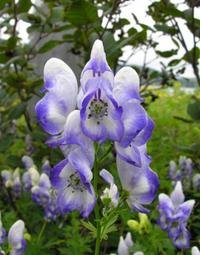
Some hybrids are 'Carneum', Stainless Steel', 'Eleonor' and 'Bicolor'
Another reasonably popular species is A. henryi. The stems may reach 2 m or more and the plant habit is somewhat sprawling with branched flower stems. Additional support is recommended. ‘Spark's Variety' has stiffer stems but still benefits from rambling through other tall neighbors. The species hails from central and western China. They are rated for zone 4. Aconitum carmichaelii is perhaps the latest species to bloom, flowering well into October. It is a great plant for extending the fall season. The cultivar ‘Arendsii' has stout stems 85-120 cm and makes a great cut-flower with short, dense racemes of dark violet-blue flowers. It is another species native to central and western China and is rated for zone 3.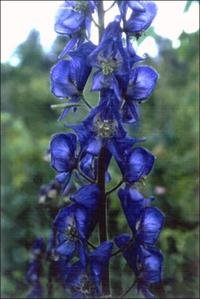
For wildflower enthusiasts, you can try our native North American species A. columbianum. It is another tall species (can reach 2 m) with violet-blue flowers but the flowers are rather scattered on the raceme compared to the standard garden varieties. However, it is an admirable species for less formal areas of the garden. The variety A. columbianum var. bakeri is much smaller, reaching just 45-60 cm. It is suitable for the rock garden. They are hardy to zone 3.
The pale-yello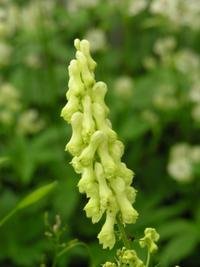 w-flowered A. lycoctonum (aka A. lamarckii, A. vulparia), commonly called wolfsbane, is a very popular perennial in European gardens, less so in North American. The flowers are more narrow than the blue-flowered species. They bloom mid-summer. Perhaps the best selection is the cultivar ‘Ivorine' (sometimes called A. septentrionale ‘Ivorine') which has larger, cream-coloured flowers on stout 80-100 cm stems. They are rated for zone 3. Another compact (45-75 cm) yellow species is A. anthora, another European native. This species has a flower shape similar to the common monkshood. It is rated for zone 5. Both of the above species can be used mid-way in the border.
w-flowered A. lycoctonum (aka A. lamarckii, A. vulparia), commonly called wolfsbane, is a very popular perennial in European gardens, less so in North American. The flowers are more narrow than the blue-flowered species. They bloom mid-summer. Perhaps the best selection is the cultivar ‘Ivorine' (sometimes called A. septentrionale ‘Ivorine') which has larger, cream-coloured flowers on stout 80-100 cm stems. They are rated for zone 3. Another compact (45-75 cm) yellow species is A. anthora, another European native. This species has a flower shape similar to the common monkshood. It is rated for zone 5. Both of the above species can be used mid-way in the border.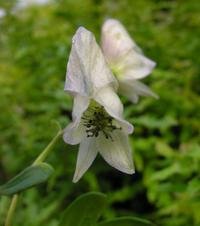
Some specialty alpine nurseries offer dwarf monkshood, most which hail from the Himalayas and mountainous areas of western China (Yunnan). Blue-violet is the standard colour in these dwarfs. Most grow 30-60 cm and produce only 3-10 flowers, but the blossoms are quite large in relation to the size of the plant. Worth tracking down are A. biflorum and A. bhutanicum. The gems of the genus are the tiny A. hookeri and A. naviculare, with stems only 10 cm tall! Most of these dwarf species are rated for zone 5-6. For a really bizarre monkshood, try to find the twining species. These vary from 1 to 2 m and literally twine around their neighbors. They have rather scattered flowers produced along the upper portions of the stems. The twining species include A. delavayi (violet-blue), A. hemsleyanum (violet-blue), A. vilmorinianum (violet-blue), A. volubile (light violet), A. tanguticum (very pale blue) and a hybrid called ‘Red Wine'(dark wine).
I would like to thank kennedyh for the use of his picture of A. columbianum; bonniewong for the picture of 'Eleonora' and veshengo for the pictures of A. napellus 'Album' and 'Stainless Steel'. These images help complete the article!
(Editor's note: This article was originally published on March 18, 2008. Your comments are welcome, but please be aware that authors of previousy published articles may not be able to rspond to your questions.)
Copyright © www.100flowers.win Botanic Garden All Rights Reserved